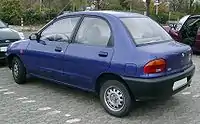Autozam Revue
The Autozam Revue is a subcompact car that was sold by Autozam, introduced in 1990. The demise of that marque led to the cars being renamed as the Mazda Revue in some markets. The car was also sold in many export markets as the Mazda 121, where it replaced the previous 121 that had been based on the first-generation Ford Festiva.
| Autozam Revue | |
|---|---|
.jpg.webp) | |
| Overview | |
| Manufacturer | Autozam Mazda |
| Also called | Mazda 121 Mazda Revue |
| Production | 1990–1998 |
| Body and chassis | |
| Class | Subcompact |
| Body style | 4-door sedan |
| Platform | Mazda DB platform |
| Powertrain | |
| Engine | |
| Transmission |
|
| Dimensions | |
| Wheelbase | 2,390 mm (94.1 in) |
| Length | 3,800 mm (149.6 in) |
| Width | 1,655 mm (65.2 in) |
| Height | 1,470 mm (57.9 in) |
| Curb weight | 806 to 860 kg (1,776.9 to 1,896.0 lb) |
| Chronology | |
| Predecessor | Mazda 121 (DA) |
| Successor | Mazda 121 (DW)/Mazda Demio |
The Revue was available in most markets as a small four-door saloon with an optional canvas sunroof added in February 1991. 1.1-, 1.3- and 1.5-litre engines were offered, with either five-speed manual or four-speed automatic transmission.
In 1996, the 121 name was shifted to export versions of the Mazda Demio, a tall, five-door hatchback, which became exported as the Mazda2 in its second generation. A Ford Fiesta, assembled at Ford's Valencia plant barely modified, but rebadged as the Mazda 121, was also sold in some markets after 1996 (where the Demio was sold at the same time with its original name). Sales of the Revue ended in Japan in June 1998.
Australia
The Mazda 121 was often referred to as the "bubble car" or "jellybean" or "the hat"[1] with the car's colour often added to the latter, for example: The little green jellybean. Australian models came standard with the 1.3 litre engine paired with the standard 5 speed manual and 4 speed automatic transmission. A 1.5 litre engine was added to the range in 1994 and was used until 1996. This generation was sold alongside its successor, the Mazda Demio also baring the 121 nameplate, for a short time between 1996 and 1997.[2]
Europe
Sold as the Mazda 121 from 1991 until 1995, the unconventional saloon was first replaced by a badge-engineered Ford Fiesta, and shortly afterwards also by the Mazda Demio 5-door estate. Sales in Europe were low.
In Belgium and the Netherlands, it is often referred as "De Bolhoed" (The bowler hat) because of its bubble shape.[3]
Engines
- 1991.01–1994 : 1.1 L (1,138 cc) B1, SOHC 8V, carburetor, 54 PS (40 kW; 53 hp) at 5,600 rpm, 8.8 kg⋅m (86 N⋅m; 64 lb⋅ft) at 3,600 rpm (Europe only)[4]
- 1990–1996 : 1.3 L (1,324 cc) B3, SOHC 8V, EGI-S, 53 PS (39 kW; 52 hp) at 5,500 rpm, 9.9 kg⋅m (97 N⋅m; 72 lb⋅ft) at 2,800 rpm
- 1990–1998 : 1.3 L (1,324 cc) B3, SOHC 16V, EGI-S, 73 PS (54 kW; 72 hp) at 5,600 rpm, 10.5 kg⋅m (103 N⋅m; 76 lb⋅ft) at 3,600 rpm
- 1991–1998 : 1.5 L (1,498cc) B5, SOHC 16V, EGI-S, 88 PS (65 kW; 87 hp) at 6,500 rpm, 12.0 kg⋅m (118 N⋅m; 87 lb⋅ft) at 4,000 rpm[5]
 Mazda 121 (Europe)
Mazda 121 (Europe) Mazda 121 with canvas roof (Europe)
Mazda 121 with canvas roof (Europe)_1.3_sedan_(2015-07-03)_01.jpg.webp) 1991 Mazda 121 (DB) 1.3 sedan (Australia)
1991 Mazda 121 (DB) 1.3 sedan (Australia)_1.5_sedan_(2009-08-29).jpg.webp) 1996–1997 Mazda 121 1.5 (Australia)
1996–1997 Mazda 121 1.5 (Australia) Interior
Interior
References
- "Boyd Briese's 1991 Mazda 121". evalbum.com.
- "Mazda 121 Australia specs".
- "Kieskeurig 1990". Archived from the original on 2021-12-22 – via www.youtube.com.
- Quattroruote: Tutte le Auto del Mondo 1992 (in Italian). Milano: Editoriale Domus S.p.A. 1992. p. 469.
- Tutte le Auto del Mondo 1992, p. 472